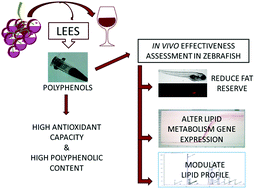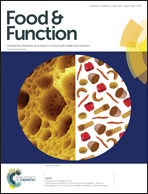Wine lees modulate lipid metabolism and induce fatty acid remodelling in zebrafish†
Abstract
This study investigates the ability of a polyphenolic extract obtained from a wine lees by-product to modulate zebrafish lipid metabolism. Lees from a Spanish winery were collected and the polyphenolic extract was chemically characterised in terms of antioxidant capacity, total phenolic content and the individual main phenolic compounds. The effects of the extract on lipid metabolism were evaluated using a zebrafish animal model. Lees are rich in polyphenols (42.33 mg gallic acid equivalent per g dry matter) with high antioxidant capacity (56.04 mg Trolox equivalent per g dry matter), rutin and quercetin being their main identified polyphenols. The biological effects of lees extract included (i) a reduction in zebrafish embryos’ fat reserve (40%), (ii) changes in the expression of lipid metabolism key genes, (iii) remodelling of the fatty acid content in phospholipid and triglyceride fractions of zebrafish embryos and (iv) reduction in the trans fatty acid content. On the whole, wine lees polyphenolic extract was effective at modulating zebrafish lipid metabolism evidencing remodelling effects and antioxidant properties that can be further developed for food innovation.



 Please wait while we load your content...
Please wait while we load your content...